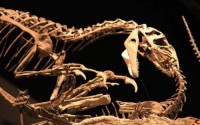Imaging Life on Earth
- Date
- 13 Oct 2015
- Start time
- 7:30 PM
- Venue
- Tempest Anderson Hall
- Speaker
- Prof Phil Manning

Prof Phil Manning, Director, Interdisciplinary Centre for Ancient Life, School of Earth, Atmospheric & Environmental Sciences, University of Manchester
Charles Darwin and Alfred Russell Wallace were the first to grasp the importance of the “endless forms most beautiful” that weave a complex web of origin, diversification and extinction of life on Earth. The evidence that fossils provide magnificently tells the story of descent with modification and the evolution of life through natural selection. Unravelling genomes and reconstructing molecular family trees (phylogenies) can now precisely measure the evolutionary distance between this tapestry of extant species.
The fossil remains that litter deep time provide a physical record for evolution of life on Earth, but are not so easy to characterize. The DNA that defines life is a fragile molecule, unable to resist even the gentlest ravages of geological time. The molecule of life is recovered from rare samples no older than 1 million years, and then only in exceptional circumstances. The proteome might be the next logical focus, as proteins are more robust and might leave tantalizing evidence for the very building blocks of life. Here the frustration is also evident to those who study such ancient molecules, as anything older than 10 million years is rare.
Is there another way that we can unpick the biological codec concealed within fossil remains? . Join Prof. Manning on a journey to see how technology is revolutionising the way we study life on Earth.
NOTE: The lecture will be preceded by Nuffield Awards presentations
Member’s report
A fossil hadrosaur, found in Hell Creek, Montana, lived not long before the extinction event at the end of the Cretaceous period. Unusually, this fossil seems to retain traces of skin and other soft tissues, as well as bones. This is providing an almost unique opportunity to reconstruct life on earth through time.
Tools for investigating fossils include spectroscopy, gel electrophoresis, even particle accelerators, which locate and identify specific atoms and molecules within the fossil, to give information about its structure and function when alive. In the fossil bird Archaeopteryx, for example, the distribution of calcium and phosphorus atoms confirm the presence of original bone material, which largely consists of calcium phosphate. Copper atoms form part of the dark pigment eumelanin in modern birds, so its distribution in Archaeopteryx gives an indication of its appearance when alive. Melanin makes feathers stronger, which is why many seabirds, for example, have black wing tips; it also informs us about the mechanics of flight. Strontium and zinc are associated with bone-healing, which makes it possible to infer that a tyrannosaur whose tail, bitten off by a rival, had survived the trauma and begun to repair the damage.
Peter Hogarth